The price of gold is up by an impressive 20% since Thanksgiving 2018. That's even a bit better than the S&P 500, which has climbed about 19%.
I'm thinking gold could hit the $1,700 level in 2020 thanks to a catalyst we haven't seen since 1999. But that's not the only thing driving gold prices.
Movement in the price of gold has largely been unnoticed by the average investor. The big money, however, has been very active in the gold market.
 Fund managers like Ray Dalio, Jeffrey Gundlach, Stanley Druckenmiller, Paul Tudor Jones and David Einhorn have all loaded up on gold recently. Even mogul Sam Zell has made a big shift from real estate to gold.
Fund managers like Ray Dalio, Jeffrey Gundlach, Stanley Druckenmiller, Paul Tudor Jones and David Einhorn have all loaded up on gold recently. Even mogul Sam Zell has made a big shift from real estate to gold.
And they might be onto something. Not only is the gold price beating the S&P this year, it's also up an astounding 38% since a low of $1,050 in 2015.
By mid-2019, central banks had already purchased $15.7 billion in gold, the highest levels on record for the first six calendar months. And so far, central banks are on pace to surpass last year's purchases of 651.7 tons. That was already up 74% over 2017 and the most in 50 years.
A number of events in the recent past have helped shift gold into high gear as we approach 2020.
Let's examine each of these individually to see how they may influence gold in the coming year.
One Long-Awaited Gold Price Catalyst
I believe there are many forces driving a surge in gold.
For example, there's a gradual move away from the U.S. dollar as official reserve currency. There are also concerns about an eventual global economic slowdown, a peak in equity, and bond markets.
But one likely overlooked driver may be the move this year by the Bank for International Settlements (BIS) to adopt an updated Basel III set of banking regulations. These are intended to promote stability in the international financial system.
Basel III reforms are vital, especially in the wake of the 2008 global financial crisis. Consider that the BIS is the trading agency for central banks, transacting gold on their behalf. What is most remarkable about Basel III is that it has reclassified gold as a Tier 1 asset for banks, meaning it's now a "zero-risk" asset.
That's likely to create more demand for gold going forward, both from central as well as commercial banks.
Already since 2008, central banks have undergone a major shift from being net gold sellers to net gold buyers, as you can see in this chart:
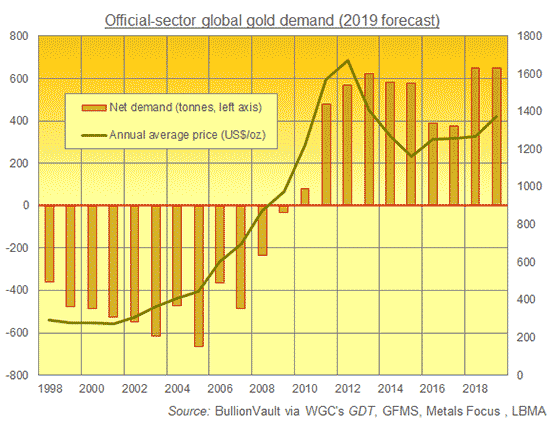
In fact, this is the first time since 1999 that there has not been a renewal of the five-year Central Bank Gold Agreement (CBGA), first signed in 1999 by 15 European central banks. The goal of the CBGA was to limit and stabilize official gold sales, which were pressuring gold prices.
The decision not to renew the agreement this year suggests there is little intent to sell gold, and therefore no need to renew the agreement. And given the moves by central banks since 2008, as shown in the above chart, the trend has clearly shifted from selling to buying.
How the Fed Is Boosting Gold Price
Of course, as gold in U.S. dollars is arguably the most-watched price, U.S. monetary developments hold plenty of weight for the gold market.
The biggest development of late has been the Fed's decision to start expanding its balance sheet once again, after almost two years of tapering it:
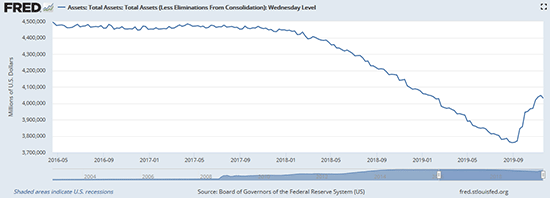
Powell's reasoning was to take a heavy-handed approach at "normalizing" the repo market, which had gone crazy on Sep. 15 with a wild spike to 10% on short-term rates.
Markets have interpreted this as a fourth round of quantitative easing, QE4, despite insistence from Powell, who said, "In no sense is this QE." Well, the Fed's balance sheet is up about 7.4% to almost $4.1 trillion after bottoming near $3.85 trillion in mid-September.
As a result, stocks are up and longer-term bonds are down. This move helps support a risk-on view towards equities. That may be unfavorable for gold in the very near term. But odds are this renewed money printing will translate into higher inflation, supporting the metal even further.
As the below chart shows, over the very long term, the value of gold reserves in USD tends to follow the trend of the U.S. monetary base. But when gold prices spike dramatically, meaning total gold value fully covers (or surpasses) the current monetary base like in the late 1930s and 1979 to 1980, it's usually time to sell.
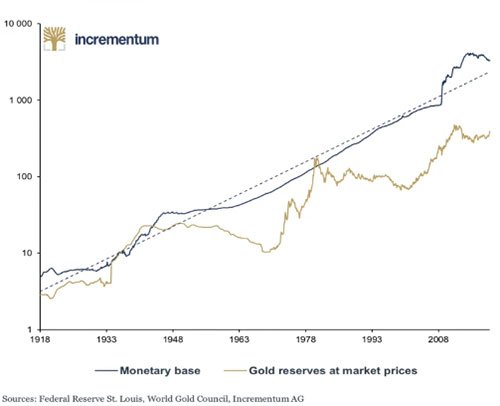
Odds are we're heading towards a similar spike in the years ahead.
In fact, let's look at what the charts are saying about the price of gold lately...
The Price of Gold in Charts
When gold peaked around $1,550 in early September this year, another significant event took place. Gold established brand new all-time highs in most major currencies, a clear sign of a bull market:
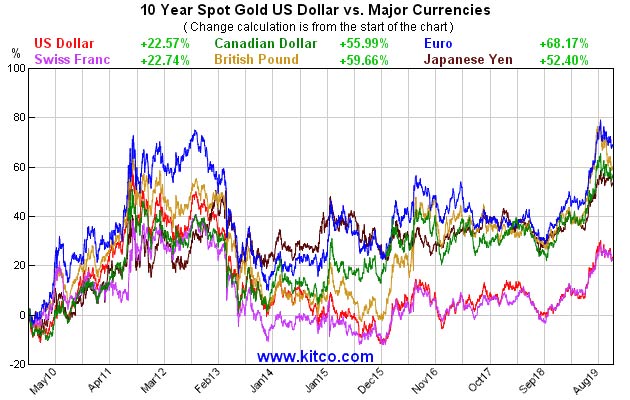
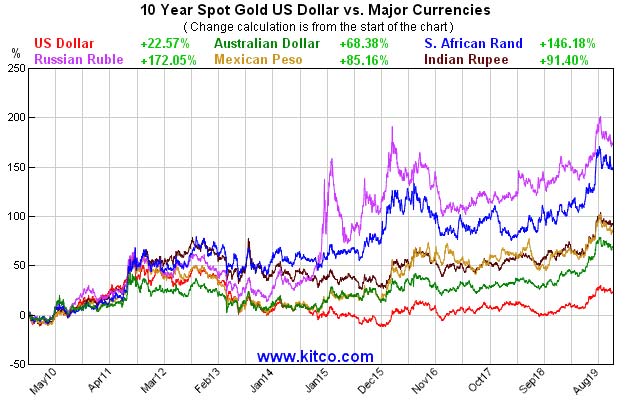
The only two major exceptions are the U.S. Dollar and the Swiss Franc. But I expect gold to resume its upward action in all currencies next year. With total global debt levels at all-time record highs, around $250 trillion and growing, it's not a stretch to understand why.
Looking at gold's technical price action also bodes well for the precious metal's future this coming year. Gold's rise since late 2015 has proved impressive so far, even if it goes widely unnoticed.
But more importantly, gold's clear surge well above long-term overhead resistance around $1,400 proves bullish:

And in this next chart, you'll also find that gold continues to hold well above its 200-day moving average of $1,400.
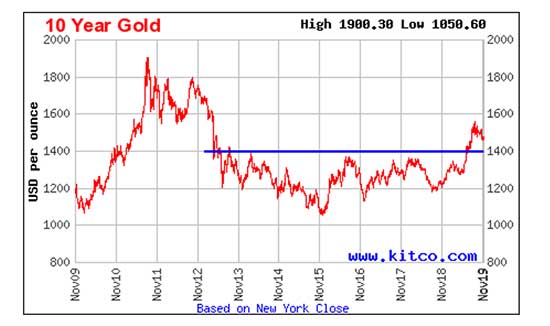
Consider, too, that gold stocks have also been acting well.

Although they have not surpassed their mid-2016 highs, I believe they will help lead gold higher once they do. And my sense is this will happen next year...
What's Ahead for the Price of Gold in 2020
[mmpazkzone name="in-story" network="9794" site="307044" id="137008" type="4"]
My view is that gold is headed considerably higher next year, but it could be in for some near-term weakness first.
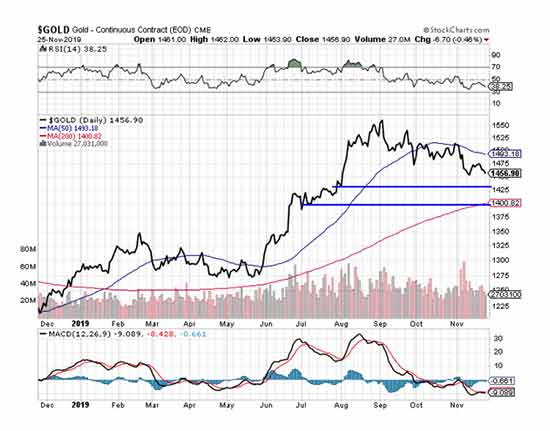
If it closes below $1,450, then odds are it will bottom somewhere in the $1,400 to $1,425 price range.
After that, I see gold first regaining this year's high of $1,550, possibly in Q1 next year, especially thanks to seasonal strength. Then, I think gold will climb higher to the $1,700 range in the latter half of 2020, as uncertainty around the U.S. election drives buying.
Even investment bank Goldman Sachs, certainly not known for being a "gold bug," is bullish on gold for next year.
In a recent report, Goldman said the gold outlook remains positive as investors seek alternative investment assets.
According to their analysts, "Investment deficit creates excess savings, supporting gold. In theory, savings should equal investment, but due to this decline in capex and a rise in precautionary cash balances, a savings surplus is beginning to develop that is supporting gold prices." They also added, "When combined with 750 tons of central bank gold purchases related to de-dollarization and defensive portfolio rotations, the savings glut means we maintain our bullish gold stance in 2020 with a target of $1600/oz."
Goldman analysts reasoned that global uncertainties, including recession worries, remain heightened. And as the Fed holds rates low, higher inflation could provide upward pressure.
Goldman's forecast is about 10% higher than the current price level, while mine is about 17% higher.
With the perfect storm of trade war fears, recession risks, the U.S. election, and a potentially peaking stock market, odds are adding up in gold's favor.
That's why $1,700 gold in 2020 is looking very attainable.
You Can Collect Four Separate Paydays in Under a Minute with This Options Trading Secret
Live on camera, America's No. 1 Pattern Trader is showing you the secret behind some of his biggest trades to date.
Watch as he uses this special tool to collect four separate paydays in under a minute - all from enormous companies like Netflix, Apple, Facebook, even Amazon.
While it may have taken Tom years to invent this moneymaking "machine," it's super easy to understand and utilize.
All it takes is a few simple mouse clicks, and you could be hundreds, even thousands, richer.
This is an opportunity you won't want to miss out on.


